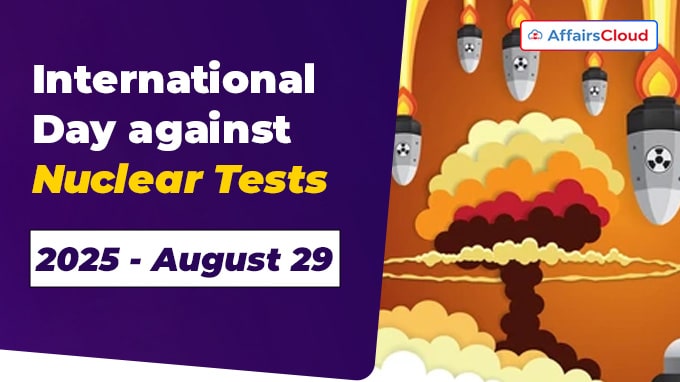 The United Nations (UN’s) International Day Against Nuclear Tests (IDANT) is annually observed across the globe on 29 August to raise awareness about the effects of nuclear weapon test explosions and advocating for a nuclear-weapon-free world.
The United Nations (UN’s) International Day Against Nuclear Tests (IDANT) is annually observed across the globe on 29 August to raise awareness about the effects of nuclear weapon test explosions and advocating for a nuclear-weapon-free world.
- 29 August 2025 marks the 16th observance of IDANT
Exam Hints:
- What? International Day Against Nuclear Tests 2025
- When? 29 August(Annually)
- Organiser: UN
- First Observance: 2010
- 2025 Significance: 80th anniversary of the first nuclear test (Trinity Test, 16 July 1945, USA)
Background:
Resolution: On 2 December 2009, the 64th United Nations General Assembly (UNGA) adopted Resolution A/RES/64/35, declaring 29 August as the International Day against Nuclear Tests.
Initiative: The resolution was introduced by the Republic of Kazakhstan with the support of multiple sponsors and co-sponsors.
First Observation: The International Day against Nuclear Tests was first observed on 29 August 2010.
Significance of 29 August: The date marks the closure of the Semipalatinsk Nuclear Test Site (SNTS) in Kazakhstan on 29 August 1991, where 456 nuclear tests were conducted between 1949 and 1989.
Related Observance: The UN International Day for the Total Elimination of Nuclear Weapons is observed every year on 26th September worldwide to raise awareness and encourage global efforts towards achieving a world free of nuclear weapons.
About Nuclear Tests:
Definition: Nuclear weapon testing involves experiments to determine the effectiveness, yield, and explosive capability of nuclear weapons.
Impact: Such tests trigger uncontrolled energy release, causing large-scale destruction.
Introduction to Nuclear Testing:
First Nuclear Test : The world’s first nuclear test under the Manhattan Project was conducted on 16 July 1945 at Alamogordo, New Mexico, United States of America (USA).
- The year 2025 marks the 80th anniversary of the world’s first nuclear test.
Device Tested: An implosion-design plutonium device, nicknamed “the Gadget”, was successfully detonated.
Test Details: Conducted at the Alamogordo Bombing Range (ABR), known as Jornada del Muerto, with the code name “Trinity”.
India’s First Nuclear Test:
Pokhran-I : India conducted its first nuclear test, code-named “Smiling Buddha” (Pokhran-I), on 18 May 1974 at Pokhran Test Range (PTR), Rajasthan.
Global Recognition: With this, India became the 6th nuclear power, breaking the monopoly of the 5 permanent UNSC members – the USA, Russia, United Kingdom (UK), China, and France.
Government Standpoint: The test was described by the Indian government as a Peaceful Nuclear Explosion (PNE).
Earlier Initiatives: In 1954, Prime Minister(PM) Jawaharlal Nehru was the first statesman to call for a nuclear testing moratorium.
- Later, the Partial Test Ban Treaty (PTBT) was adopted in 1963, banning tests in the atmosphere, outer space, and underwater.
Comprehensive Nuclear-Test-Ban Treaty (CTBT):
Adoption: The UNGA adopted the CTBT on 10 September 1996, aiming to eliminate nuclear testing.
Scope: The treaty bans all nuclear explosions (military or peaceful) and consists of a preamble, 17 articles, 2 annexes, and a Protocol with 2 annexes.
Implementation Body: The resolution CTBT/MSS/RES/1, adopted on 19 November 1996, established the Preparatory Commission for the Comprehensive Nuclear-Test-Ban Treaty Organization (CTBTO).
Verification: The CTBTO Preparatory Commission operates an International Monitoring System (IMS) with over 300 facilities to detect any nuclear explosion.
Signatories: As of 2025, 187 States (Countries) have signed and 178 have ratified the treaty. India has not signed the CTBT.
About United Nations (UN):
Secretary-General – António Guterres
Headquarters – New York, the United States of America (USA)
Established – 1945




